My City Tagged My Tree, Now What?
As Emerald Ash Borer (EAB) continues to impact trees across Minnesota and the Twin Cities metro area, some residents are returning home from work to find their ash tree marked indicating it must be removed—often within as few as 30 days. What may be more surprising is that cities are not only “tagging” trees growing along the public right-of-way, but also private trees located anywhere on the property—including back yards. Below our tree care experts have provided answers to frequently asked questions by homeowners about a tree tagged for removal by your city!
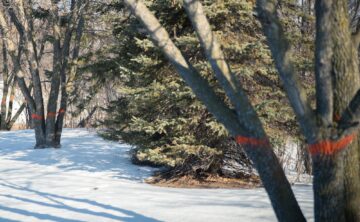
What should I do if the city marks my tree for removal?
In general, the person who owns a property is responsible for the trees growing on it. But trees don’t grow neatly along property boundaries. Limbs and roots may impact more than one yard. The vast majority of the time, this is a great thing. A large shade tree can make a neighborhood feel like home. At other times, roots or limbs may impact neighboring properties, or activity such as construction may impact a neighbor’s tree. And just like people, sick trees can make other trees sick. In these instances, action on one property must be taken to avoid negatively impacting others. If the city has marked your tree, it is important to take the action required by your municipality to avoid possible fines.
Can a city require a homeowner to remove a privately owned tree?
In Minnesota, which pests or diseases may require a tree to be removed?
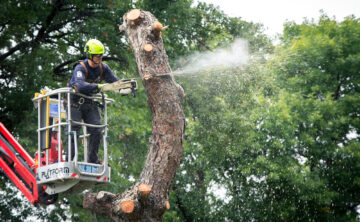
- Oak wilt is a fast-moving, deadly fungal disease that impacts red and white oaks. It spreads through insect carriers and tree root systems. An infected tree must be treated or removed to prevent neighboring trees from being infected.
- Dutch elm disease (DED) is a fungal disease carried by elm bark beetles and can be spread through tree roots. If caught early, it is possible to cut out an infected area of a tree and treat it.
- Emerald ash borer (EAB) is an invasive pest that kills unprotected ash trees. Treatments are effective in preventing EAB, but time is running out. Homeowners should plan to have their ash trees treated this summer, or removed this winter.
What should I do if my tree has been "tagged" due to Emerald Ash Borer (EAB)?
If your ash tree (or any other tree) has been marked by your city, contact your local forestry or parks department for more information. Some cities use different colors of spray paint to indicate which of the three health concerns were found. Most often there will be other information left behind, such as a doorknob sign with instructions for you to follow.
Additional frequently asked questions about "tagged" ash trees
Minnesota tree experts recommend treating ash trees this summer. After that, it may be too late to save them. This is because ash trees must be healthy enough for the treatment to be effective. If the insect damage has advanced too far, the tree simply can’t recover. Because the borers feed under the tree’s bark, there may be extensive damage long before it is outwardly visible.
Unfortunately, all unprotected ash trees in the Minneapolis & St. Paul metro area are at a high risk of dying from an emerald ash borer infestation. If the tree is showing signs of dying, plan to remove it soon. If the tree is still reasonably sound, plan to remove it in the winter. That way you can enjoy one last summer of shade, and enjoy the benefits of winter removals, including reducing the impact to other parts of the landscape when it’s frozen.
If your tree isn’t a good candidate for treatment, our experts recommend removal. If your ash tree is showing signs of dying, plan to remove it soon. If the tree is still reasonably sound, plan to remove it this winter. That way you can enjoy one last summer of shade, and enjoy the benefits of winter removals, including reducing the impact to other parts of the landscape when it’s frozen.
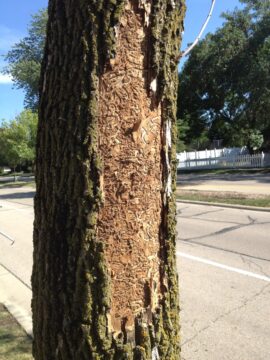
The experts at Rainbow Treecare can help you with your ash tree
If your tree has been marked for removal, contact us to schedule a consultation for removing it. Our experts can also help you pick a replacement tree that matches what you want and that has the best chances of thriving in the unique conditions of your yard.
Other items you may be interested in:

Finding the Right Ash Tree Replacement in Minnesota
Many people across Minnesota are losing their ash trees because of Emerald Ash Borer (EAB), an invasive species of beetle from Asia. EAB larvae feed on the
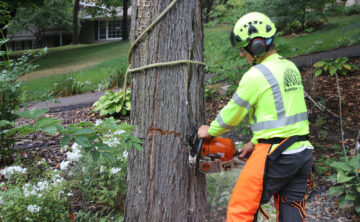
Tree & Stump Removal
Tree and Stump Removal Services in Minneapolis As the largest, locally-owned tree removal company in the Twin Cities Metro, you can count on the experts
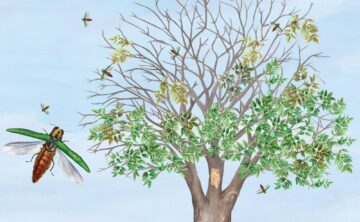
Emerald Ash Borer
Save Your Tree: Treatment for Emerald Ash Borer If you live in the Minneapolis & St. Paul metro, there is a good chance you have



